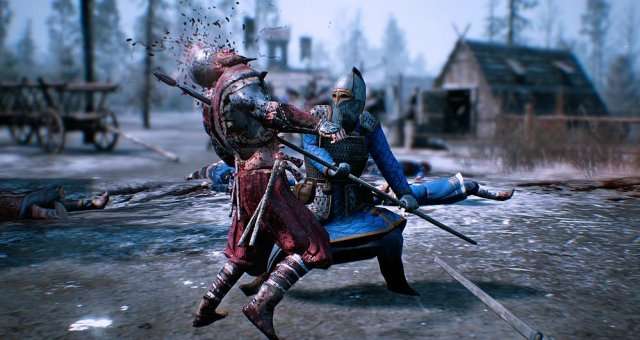
I am writing this guide to help the new players understand the finer points of Ancestors Legacy. If you have not completed the first viking campaign, than I suggest you do so. This guide is based on you having finished all the missions of the first viking campaign. AL is not like many other RTS. It shares many of the same roots as Company of Heroes, but with a few key changes beyond the obvious. I will attempt to clarify some of the key features in this guide.
Villages
All credit goes to Zorbaz!
The life blood of your army
Villages come in three types: bronze, silver and gold. Each village will provide a combination of food, wood and iron. All villages are not equal. When you are taking a village, especially at the start of the game. It is important to send enough squads to take them. You can tell the strength of each village—neutral, allied, or enemy—by looking at the frame color around the village health bar.
Average number of squads required to take an unfortified village:
Bronze Village – 1 Squad, Silver Village – 2 Squads, Gold Village – 3 Squads
(Exception, viking blacksmiths can upgrade building HP, Viking villages can be harder to take.)
Once you control a village be sure to send the villagers back to work. This can be done by directly clicking the village on the battlefield, or by the buttons in the lower right side. It is important to always keep your villages producing.
Conquering and Defending Villages
To starve or not to starve
When you are defending a village from enemy attack you need to decide if your village is worth spending wood and men to defend and fortify. Traps, tower and upgrades can be used to fortify your villages, but this is costly. You might be better served by keeping your squads near by to defend the village. Fighting under your towers and town hall is an effective defensive strategy. The enemy will lose more men fighting in a village you control.
The following are some of the most effective defensive strategies for holding villages. Any combination of these can be used to fortify your villages.
- Ring the town bell to call all your villagers to defend the town hall. It will take several seconds for your villagers to return to your town hall. The more villagers in the town hall, the more effective the defense. Always do this, if you do not the enemy can easily take the village. When your villagers are defending the town hall they are not producing resources.
- Place a squads to fight under the defenses of the town hall. Placing additional troops near by can prolong your town hall’s survival. Order the troops to retreat once they have taken losses, and the battle is nearly lost.
- Place traps at choke points in or around the village. If the enemy is in defensive stance they will see the traps and destroy them, but it buys you time.
- Build towers to fortify the town. Towers do extra damage to the enemy, but they can be burnt down. If the enemy has catapults it is futile to build towers.
When you are planning on attacking any village, figure out how many squads you will need. You will also need to consider sending extra squads because of enemy towers, traps, and squads. Catapults are very effective at destroying villages and destroying towers, but they require squads to take the village and guard them from enemy squads. Fighting under fire from enemy towers and town hall is a costly offensive strategy. You will lose more men fighting enemy squads in a enemy village.
The following are some of the most effective offensive strategies for taking villages. Any combination of these can be used to conquer the enemy village.
- Use catapults or archers to destroy everything from range while keeping some infantry in front of them, in case of counter attack. This works with or without enemy squads in the village.
- Rush village regardless of towers. This is best when no enemy squads are near by. If you destroy the town hall the towers will be automatically destroyed.
- Burn the towers with a squad or two per tower, then pull back to heal before launching the final attack. This is best when the enemy has squads in the town
- Kill the villagers working the iron, food and wood sites before attacking the town hall. Rush your squads to the front door of the enemy town hall and kill villagers as they enter the front door. If villagers are killed before they enter town hall, than town hall becomes less effective at defending itself.
Starving
A painful mistake
If you have more squads than your villages food production can support, then you will start to lose stockpiled food. When you run out of stockpiled food your squads will starve. If your squads are starving, then your squads will be defeated in fights you should have won. When training squads keep in mind the increased food upkeep.
Do what you can to avoid starving. You can strike at enemy food production to starve him. Starving will put a player at a large disadvantage.
- Try taking a village with food production.
- Factions may have techs that reduce upkeep, or boost food production.
- Factions may have have prayers that reduce upkeep or boost production.
- Make sure your village farms are producing food.
- You can disband some of your excess squads.
The viking upkeep reduction tech is basically required for the vikings as the game progresses. The saxons and germans upkeep reduction is useful but not required. While the slavs should frequently use the upkeep prayer. Both the vikings and slavs have a production boost tech. This boosts your production for your base, and can be useful but not amazing.



Be the first to comment